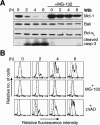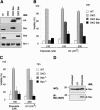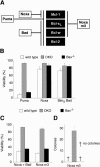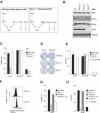Proapoptotic Bak is sequestered by Mcl-1 and Bcl-xL, but not Bcl-2, until displaced by BH3-only proteins
- PMID: 15901672
- PMCID: PMC1142553
- DOI: 10.1101/gad.1304105
Proapoptotic Bak is sequestered by Mcl-1 and Bcl-xL, but not Bcl-2, until displaced by BH3-only proteins
Abstract
Commitment of cells to apoptosis is governed largely by the interaction between members of the Bcl-2 protein family. Its three subfamilies have distinct roles: The BH3-only proteins trigger apoptosis by binding via their BH3 domain to prosurvival relatives, while the proapoptotic Bax and Bak have an essential downstream role involving permeabilization of organellar membranes and induction of caspase activation. We have investigated the regulation of Bak and find that, in healthy cells, Bak associates with Mcl-1 and Bcl-x(L) but surprisingly not Bcl-2, Bcl-w, or A1. These interactions require the Bak BH3 domain, which is also necessary for Bak dimerization and killing activity. When cytotoxic signals activate BH3-only proteins that can engage both Mcl-1 and Bcl-x(L) (such as Noxa plus Bad), Bak is displaced and induces cell death. Accordingly, the BH3-only protein Noxa could bind to Mcl-1, displace Bak, and promote Mcl-1 degradation, but Bak-mediated cell death also required neutralization of Bcl-x(L) by other BH3-only proteins. The results indicate that Bak is held in check solely by Mcl-1 and Bcl-x(L) and induces apoptosis only if freed from both. The finding that different prosurvival proteins have selective roles has notable implications for the design of anti-cancer drugs that target the Bcl-2 family.
Figures








Similar articles
-
Mitochondrial permeabilization relies on BH3 ligands engaging multiple prosurvival Bcl-2 relatives, not Bak.J Cell Biol. 2007 Apr 23;177(2):277-87. doi: 10.1083/jcb.200606065. J Cell Biol. 2007. PMID: 17452531 Free PMC article.
-
Hierarchical regulation of mitochondrion-dependent apoptosis by BCL-2 subfamilies.Nat Cell Biol. 2006 Dec;8(12):1348-58. doi: 10.1038/ncb1499. Epub 2006 Nov 19. Nat Cell Biol. 2006. PMID: 17115033
-
How the Bcl-2 family of proteins interact to regulate apoptosis.Cell Res. 2006 Feb;16(2):203-13. doi: 10.1038/sj.cr.7310028. Cell Res. 2006. PMID: 16474435 Review.
-
Collaborative orchestration of BH3-only proteins governs Bak/Bax-dependent hepatocyte apoptosis under antiapoptotic protein-deficiency in mice.Cell Death Differ. 2025 Jun;32(6):1153-1166. doi: 10.1038/s41418-025-01458-y. Epub 2025 Feb 24. Cell Death Differ. 2025. PMID: 39994353 Free PMC article.
-
Structural biology of the Bcl-2 family of proteins.Biochim Biophys Acta. 2004 Mar 1;1644(2-3):83-94. doi: 10.1016/j.bbamcr.2003.08.012. Biochim Biophys Acta. 2004. PMID: 14996493 Review.
Cited by
-
Gefitinib analogue V1801 induces apoptosis of T790M EGFR-harboring lung cancer cells by up-regulation of the BH-3 only protein Noxa.PLoS One. 2012;7(11):e48748. doi: 10.1371/journal.pone.0048748. Epub 2012 Nov 21. PLoS One. 2012. PMID: 23185274 Free PMC article.
-
Epigenetic silencing of Bim transcription by Spi-1/PU.1 promotes apoptosis resistance in leukaemia.Cell Death Differ. 2013 Sep;20(9):1268-78. doi: 10.1038/cdd.2013.88. Epub 2013 Jul 12. Cell Death Differ. 2013. PMID: 23852375 Free PMC article.
-
α-Tomatine-mediated anti-cancer activity in vitro and in vivo through cell cycle- and caspase-independent pathways.PLoS One. 2012;7(9):e44093. doi: 10.1371/journal.pone.0044093. Epub 2012 Sep 6. PLoS One. 2012. PMID: 22970166 Free PMC article.
-
Selective BCL-XL Antagonists Eliminate Infected Cells from a Primary-Cell Model of HIV Latency but Not from Ex Vivo Reservoirs.J Virol. 2021 Jul 12;95(15):e0242520. doi: 10.1128/JVI.02425-20. Epub 2021 Jul 12. J Virol. 2021. PMID: 33980597 Free PMC article.
-
Up-regulation of Mcl-1 and Bak by coronavirus infection of human, avian and animal cells modulates apoptosis and viral replication.PLoS One. 2012;7(1):e30191. doi: 10.1371/journal.pone.0030191. Epub 2012 Jan 11. PLoS One. 2012. PMID: 22253918 Free PMC article.
References
-
- Adams J.M. 2003. Ways of dying: Multiple pathways to apoptosis. Genes & Dev. 17: 2481-2495. - PubMed
-
- Antonsson B., Montessuit, S., Sanchez, B., and Martinou, J.C. 2001. Bax is present as a high molecular weight oligomer/complex in the mitochondrial membrane of apoptotic cells. J. Biol. Chem. 276: 11615-11623. - PubMed
-
- Bae J., Leo, C.P., Hsu, S.Y., and Hsueh, A.H. 2000. Mcl-1S, a splicing variant of the antiapoptotic Bcl-2 family member Mcl-1, encodes a proapoptotic protein possessing only the BH3 domain. J. Biol. Chem. 275: 25255-25261. - PubMed
-
- Chen L., Willis, S.N., Wei, A., Smith, B.J., Fletcher, J.I., Hinds, M.G., Colman, P.M., Day, C.L., Adams, J.M., and Huang, D.C.S. 2005. Differential targeting of pro-survival Bcl-2 proteins by their BH3-only ligands allows complementary apoptotic function. Mol. Cell 17: 393-403. - PubMed
-
- Cheng E.H.-Y., Levine, B., Boise, L.H., Thompson, C.G., and Hardwick, J.M. 1996. Bax-independent inhibition of apoptosis by Bcl-xL. Nature 379: 554-556. - PubMed
Publication types
MeSH terms
Substances
Grants and funding
LinkOut - more resources
Full Text Sources
Other Literature Sources
Molecular Biology Databases
Research Materials
